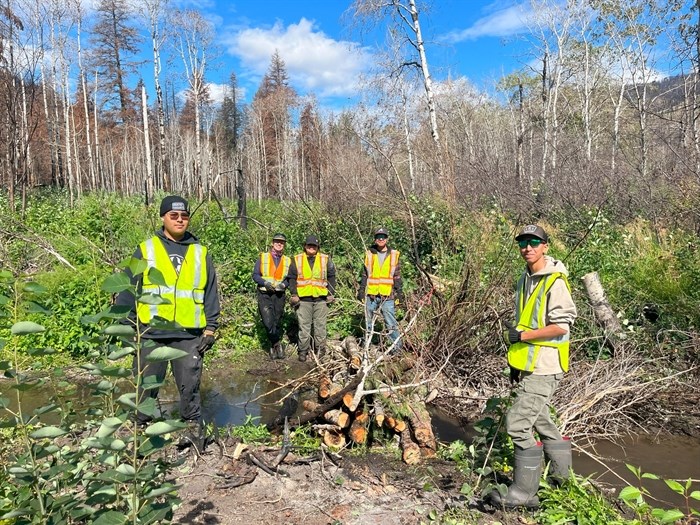
Members of the B.C. Wildlife Federation team up with the nle?képmx Guardians near Spences Bridge to build a beaver dam in September.
Image Credit: SUBMITTED/ B.C. Wildlife Federation
September 19, 2025 - 6:00 AM
More than 100 beaver dams made of natural materials have recently been installed in B.C. to help mitigate the detrimental loss of wetlands that's contributing to increasing wildfire activity and drought, and having a destructive impact on fish and wildlife.
Wetlands have been dwindling over the past couple of decades due to human development, logging and the removal of millions of an industrious, native species — the beaver.
Executive director of the BC Wildlife Federation Jesse Zeman said roughly 90 per cent of wetlands in the province have been lost to development to date.
“There are few in the Okanagan that are being filled in right now for development. We’ve got rid of the majority of them here and it’s the same in Kamloops,” he said. “Protecting them has been a challenge for a long time. B.C. needs a wetlands policy.”
Beaver dams create natural wetlands and ponds that can remain untouched even when the forest around them burns. Zeman said areas without beaver dams lose three times as much vegetation during wildfires as areas with plentiful beaver dams.
“Beavers have disappeared for a number of reasons. There are areas where there are problems where beavers and people don’t get along and municipalities that will pay to euthanize them in areas where they’re flooding infrastructure,” Zeman said.
Crews with the federation’s 10,000 Wetlands Project recently installed more than 100 beaver dam analogues, which are wooden structures that mimic beaver dams made from locally sourced natural materials.
“It doesn’t take much technology and its inexpensive,” Zeman said. “We’re kind of putting them all over the province where we can find suitable locations. We’ve installed some with Skeetchestn and the Okanagan Nation Alliance.”
Part of the work involves introducing beavers to the locations so they can take over the work.
“We think there’s an opportunity to repurpose beavers deemed a nuisance and put them somewhere else,” he said. “Beavers are cheap and they work 24/7. We like beavers.”
The federation is also working on prescribed burning and cultural burning projects with numerous First Nations to mitigate wildfires.
For thousands of years Indigenous people managed the area with prescribed and cultural burning that restored native grassland and shrub-steppe ecosystems, providing forage for large mammals.
“We do around 60 projects a year working with First Nations trying to figure out places that need help and figure out a way to do it together,” Zeman said. “We do it all over the province. We learn a lot from them and knowledge keepers about how they used to do things and what they know about the land.”
Funding to secure watersheds is running out and much more is needed for the future.
“The lack of funding as it relates the environment is a huge concern for us,” Zeman said. “The province was investing money in watershed security and put an initial endowment into a fund but we’re worried next year they won’t be funding and without it a number of these projects will go to the wayside which means more floods, more erosion and more fire.”
Zeman extended gratitude to the volunteers who work with the federation on restoration projects across the year.
Go here learn about the B.C. Wildlife Federation, volunteer or donate to its projects.
To contact a reporter for this story, email Shannon Ainslie or call 250-819-6089 or email the editor. You can also submit photos, videos or news tips to the newsroom and be entered to win a monthly prize draw.
We welcome your comments and opinions on our stories but play nice. We won't censor or delete comments unless they contain off-topic statements or links, unnecessary vulgarity, false facts, spam or obviously fake profiles. If you have any concerns about what you see in comments, email the editor in the link above. SUBSCRIBE to our awesome newsletter here.
News from © iNFOnews, 2025